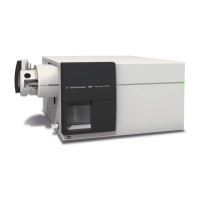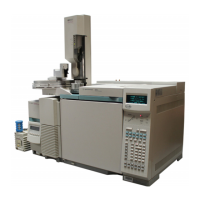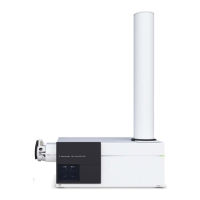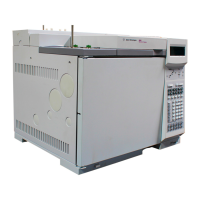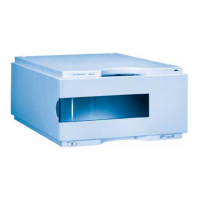Installation Completion and System Verification 3
Step 1. Condition the Agilent LC instrument
Agilent 6400 Series Triple Quad LC/MS System Installation Guide 51
minutes at 3 mL/minute. Do 5 injections with the flushing solvent to clean
the injector path and sample loop.
Alternatively, while the Triple Quadrupole LC/MS pumps down, the
flushing solvent can be pumped at a low flow rate (e.g. 0.1 mL/minute)
overnight.
7 Set up the pump module again to deliver HPLC grade isopropanol for 5
minutes at 3 mL/minute. Do 5 injections with isopropanol to clean the
injector path and sample loop.
8 If applicable, remove the c-tubes from the degasser channels plumbed in
series and reconnect the degasser tubing to the original configuration.
9 Install the column used for installation verification (p/n 959757-302) and
wet the column with 100% methanol.
All columns shipped with the Triple Quadrupole LC/MS are shipped dry.
Upon installation, these columns must be primed or wetted with Methanol
to properly condition the column.
10 Set up the pump module again to deliver HPLC grade methanol for at least
30 minutes at 0.5 mL/minute. Make sure that the solvent stream selector
valve on the Triple Quadrupole LC/MS is set to waste position or the outlet
tubing from the column is not connected to the instrument.
If the HPLC Stack has a Thermostatted Column Compartment (TCC), set
the temperature of the column compartment to 60°C to reduce the back
pressure and to help remove any contaminants on the column.
11 For negative mode checkout (all models except 6410):
a For 6470/6495 only, install the trapping column. See Figure 29
b For Channel A, install 1 liter of 100% water.
c For Channel B, install 1 liter of 100% methanol.
d Make sure flow rate is set to 0.5 mL/minute with 70:30 water:methanol
to condition column with checkout mobile phase.
e Do 5 injections with the blank premixed mobile phase (70:30 water:
methanol) to clean the injector path and sample loop.
Make sure that the flushing solvent does not stay in the LC for an extended period of
time (for example, several days) because the cyclohexane may be harmful to the pump
seals.
